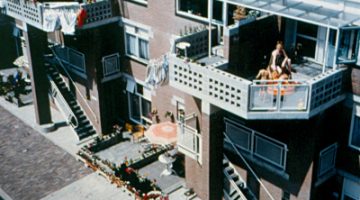
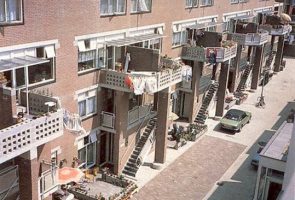
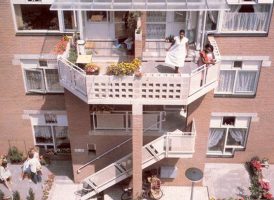
Haarlemmer Houttuinen Housing
Main objectives of the project
Date
- 1987: Construction
Stakeholders
- Architect: Architectuurstudio HH
Location
City: Amsterdam
Country/Region: Amsterdam, Netherlands

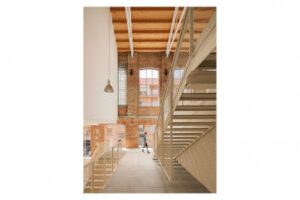

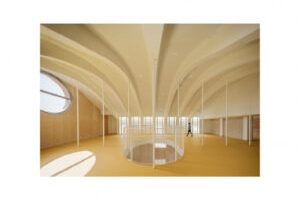
The transformation project of the warehouse building of the old industrial complex of Fabra & Coats in Barcelona is included in the process of reconversion of this textile complex of the XIX and XX centuries to incorporate it to the "BCN creation factories" network.
The intervention in the building activates all the elements of the original building creating the new program, and reuses its physical, spatial and historical qualities to make the new construction more efficient and to reinforce the character of the original building.
The original building is 100m long, where the first decision was to bring the value of its maximum dimension, which is the length. We access through the center creating an interior square where the promenade of the interior stairs begins in diagonal double ascending. The original building is communicated physically and visually from the ground level until the roof structure. This vestibule also connects the building to Parellada Street and the Fabra & Coats complex square. This new communal space is the new structural contribution to the original building.
The new construction is by assemblage, it is a dry construction with just few materials, as in the original industrial building. Wood is used in all its forms: solid, agglomerated, cross laminated… Materials are joined as if it was a textile. To sew and un-sew, the new construction by its character and assemblage, can be assembled and disassembled, so it is “reversible”. The building, in the future, as a heritage element, can return to its original form of 1905, and the material used in its construction can be recycled.
Structural reuse of the two inner floors of the building, using them without any reinforcement (load capacity of 1,100kg/m2) to support on both floors the two new levels of housing. We convert two floors into four, to reach this we use a wooden structure, because it is 5 times lighter than a steel structure. The wooden frame structure is a translation of the old steel structures used as shelves for the storage of the threads.
Façade and roof of the building as a thermic buffer for the housing units. The new housing units are placed separated from the façade and the original roof of the building, with a new wooden façade.
The in-between space is created to circulate the air; therefore, the housing units do not require the air conditioning the most part of the year. The 45cm brick wall and the ceramic tile roof of the original building provide its thermal and shading properties to the new interior building, while maintaining its presence as an interior façade of the communal spaces. In this in-between space are the inner streets to access to the houses, identifying the old path of the thread packages through the crane bridge and the conveyor belts. The former textile complex of Fabra & Coats in Barcelona, built between the 19th and 20th centuries, is being gradually recovered to incorporate it into the “BCN creation factories” network. More than 28,000m2 in public buildings and social housing will be added to the Sant Andreu neighborhood.
One side of the building, the result of an extension on 1950, has been destined for the headquarters of the “Colla Castellera Jove” in Barcelona. The adjacent building, 100 m long, has been transformed into a complex of 46 social housing units.
To configure the main space, the training room for human towers (10x10x10 m), is based on the analysis of human towers: pyramidal structures that work, ideally, with pure compression. Due to their operation, they fill the space, creating an empty space around them.
The new structure is conceived in a complementary way to a human tower: it works like a shell, creating an empty space inside. The upper floor under roof is a three-dimensional suspended structure that does not make its operation evident.
The project combines for the first time the rehabilitation of industrial heritage, the creation of social housing and wood construction. The elastic joints of the new elements resolve the compatibility between the two constructions and achieve acoustic comfort in homes that is higher than the standard.
Conditions
Minimum dimensions in construction solutions
Economic limit: PEM € 1,021 / m2
Reversible construction in response to equity
Implemented solutions
Light construction
Activate the building
Elastic joints in new construction
Achievements:
Rehabilitation in place of new construction:
Reduction of consumption in construction
Reduced demand in operation
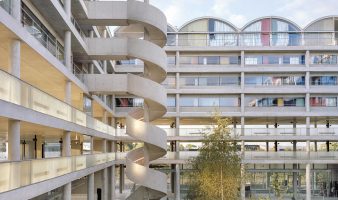
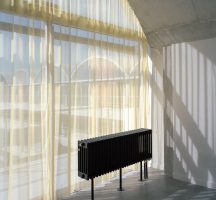
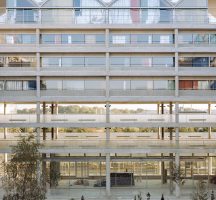

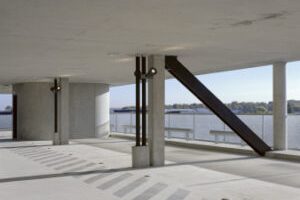
185 social student housing units associated with a reversible car park (housing/offices) with a superstructure of 500 spaces, sports hall, multi-purpose hall and shops
The volume of the building is based on the rectangular shape of the land and assumes its U-shape which encloses the interior of the block. This interior, treated as an open-air garden, is the real lung of the project. Rather than a building, the project should even be presented as an economical and equipped structure. The programme brings together several disparate elements (student accommodation, communal facilities, shops, public and private car parks). The distribution of the different programmes follows a logic of superposition: a double-height ground floor hosting the shops and collective spaces of the student residence; two levels R+1 and R+2 in a large open plateau for public parking spaces; at levels R+3, R+4 and R+5, three levels of housing; and finally an attic level hosting the upper levels of some duplex housing.
As well thought out on the scale of the car as on that of the individual, the building seeks a way between a strictly functionalist approach and that constrained by domestic standards. The clarity of these structural responses allows the building to offer great flexibility and reversibility of use. A Housing program in the heart of the Plateau de Saclay raises some questions: It means to imagine how to live together in an urban environment, founded on its well thought landscape qualities and its situation in a large scale territory. This future hub of activities is located in the centre strip of the Quartier de l’école Polytechnique. The way it has been drawn looks like an American campus inspiration, mostly because of its continuous organisation, which forms a series of compact and opened blocks. The project is part of this strong urban system. Beyond the regularity of this drawing, the question of reversibility has already been well thought, especially regarding mobility.
Our project is founded on these future possible mutations, of uses and space. In its main lines, the project adopts the same morphology of its neighbours. It enhances the existing strong urban lines, but adds a large central space. This large shared garden is the main link between all the different activities of the project. The project distinguishes itself thanks to the presence of this garden. It brings views and breathing, at every floor.
The structure and the program take part in a unique logic. The project is ruled by a sense of economy, in space and in function. It stands as its identity. Following this idea, the building is as compact as it can be. The logic of implantation develops 16m large floors, allowing light to enter, following the whole circumference of the building. The inside spaces are also quite generous, with a 2m50 high for housing and 2m75 for the car park. The ground floor is even higher, 5m25 high, in order to give the possibility to add mezzanines. The strong structure is not only rigorous but also generous.
In the end, the structural grid is more generous than the one usually used in housing programs. The efficient structure is a real choice, using concrete slabs and columns, and allows to get rid of the usual transversal concrete walls. It reinforces the possibilities of variations in the organization: For example, the conversion between a T4 in T1 is very simple.
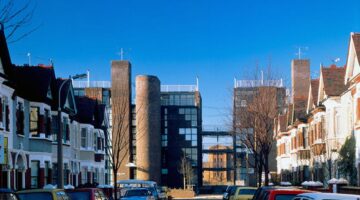
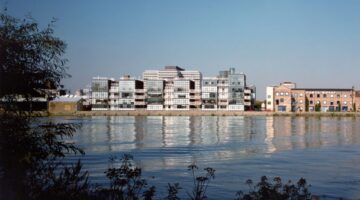


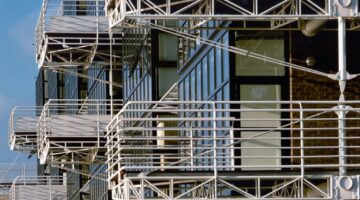
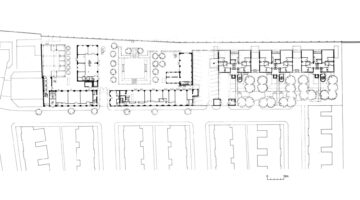
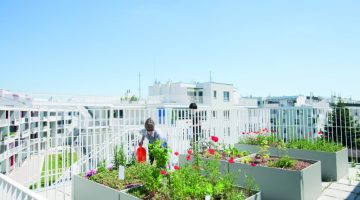
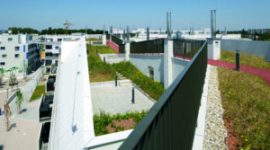
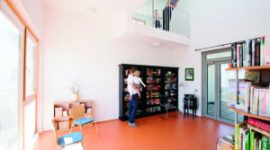
After the competition, the team engaged in discussions with various stakeholders, including Wien Holding, GESIBA (the housing cooperative), the district head, and the Europan secretary. They refined their ideas and concepts and considered rezoning the area but ultimately decided to make slight adjustments to the urban plan instead. The project was approved to be realized under the Wienese Subsidised Housing framework, leading to the division of the site into three parts and the initiation of another competition called Bauträgerwettbewerb. Studio uek was invited to build one part of the project and contribute to the competition brief. Additional experts were involved to address landscape architecture and participation, resulting in rules and regulations that complemented the existing zoning. The project focused on urban porosity and connecting the housing project with the surrounding area. Two other teams were selected to build the remaining parts, each with their own housing concepts. Studio uek constructed 171 housing units, including sheltered housing and a geriatric day center, and incorporated common spaces and a roof-top route that connects the three parts. The participative activation process allowed residents to define programs for smaller communal spaces and participate in the management of rooftop flowerbeds and gardens. Just after the competition, the team entered in a discussion phase with several actors included Wien Holding, the head of the housing cooperative GESIBA, the head of the district and Europan secretary. They had to sharpen their ideas and their concepts. It was also discussed whether the team should consider rezoning the area but then they decided that through a slight translation of the urban plan without really losing a lot of the qualities, they could avoid this time consuming process. At the end of this first phase it was decided that the project should be realized within the framework of the Wienese Subsidised Housing, which meant that the site should be divided into three smaller parts and thar another competition called Bauträgerwettbewerb should take a place. The team was invited both to build one part of this project and to contribute to elaborate the competition brief. In order to pursue their idea from Europan competition, the team involved additional experts for landscape architecture and for participation and all together they formulated additional rules and regulations for this competition brief, which should complement the existing zoning. These rules concerned the configutation of the whole project, but also the character of the garden courtyard, the rooftop route, several main common spaces in each project part and thar should be included in each project a participative activation process.
Studio uek worked on this specific element of urban porosity, on connecting points between the outside road, the surroundings and the inside world of the housing project. Two Austrian teams were selected to build the two other parts of the area. The first one (ARGE Köb&Pollak / Alexander Schmoeger) on the North side worked on experimental housing providing apartments from a very small size like 30m2 up to big shared apartments. The second team (goya ZT GmbH), in the South part, focused on young and urban housing with a lot of sports and leisure facilities inside the housing project. Studio uek built 171 housing (of which 30 are sheltered housing) + a geriatric day centre. The three built parts have some common spaces dedicated, for some of them, to support the small community of the building and for some other, to offer possibilities to inhabitants of the whole project (like the “play and celebration space” in the studio uek part). A roof-top-route links the three built parts offering also collective spaces (like tenants flowerbeds, glass house, summer kitchen…)
The participative activation process allowed inhabitants to define the programs for smaller common spaces and they were also involved in the management of the flowebeds / garden on the roof.
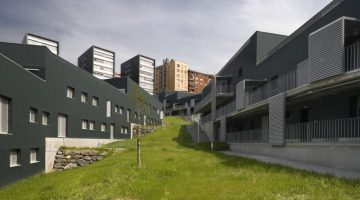
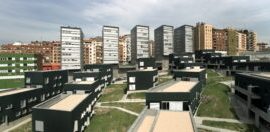

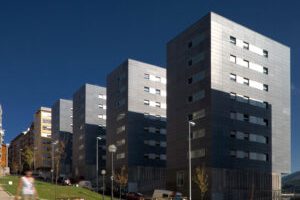
The site was a former iron mine, with a topography that had slopes of up to 50 meters, surrounded by a disorganized and degraded residential outskirts to the north and by the channelled Nervión River and the Miraflores peninsula and Miribilla to the south. The frontier character of the site and its ambiguous and hybrid qualities are preserved. A comb-shaped footprint of several towers separated by lookouts works as a visual filter from the urban environment behind, generating a new façade for the city, introducing order and repetition. In addition, is planned a low-rise, introverted, residential core surrounded by a taller permeter dedicated to offices, amenities, retail areas and civic buildings.
The perimeter acts both as a connector to the neighbourhood and the old road to San Sebastian, as well as a visual and acoustic barrier. On the other hand, the existing neighbourhood, which is very dense, needed porosity, so two sun-filled squares with views were preserved with the open spaces between towers acting as urban lookouts. In the core of the cluster, the buildings rise from a carpet of green spaces that act as intermediary spaces.
Six residential buildings spill randomly throughout the hill, almost like a river, without subordinating themselves to parallel alignments, but controlled by a rational geometry. The buildings, following the idea of long-tiered-sigzag, generate a series of exterior voids that get narrower and wider, creating an intermediate scale of communal spaces.
The mixed typology of the buildings combines the volume of the single-family row housing and the functionality of a social housing building with access through corridors. Each unit is accessed from the outside, with independence, provided by its individuality, but stacked one on top of each other, using the collective logic. The longitudinal orientation of the building, approximately north-south, determines that the access corridors, where the entry halls, kitchens, laundry rooms, and bathrooms are facing, need to look north. The south façade, facing the ideal sun conditions and views, is then dedicated to bedrooms and living rooms.
“End and top off the edge of town. It was the responsibility of the proposed architecture to order against confusion”.
“Convert the upper street to a viewer street. The buildings will mark, surprise with different views different from the other side”.
“Project houses to look to the landscape and noon, the park and the streets”.
“It is about Sewing vertically, assigning that role to the own building”.
The result all the premises of the place and the intentions on the project are five residential towers perched on a stepped base (due to the sharp slope) that absorbs all the sector garages which is accessed by a new street below; intermediate semi-public squares looking at the views across the Nervión; all the living rooms facing the midday sun.
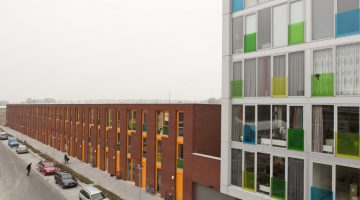
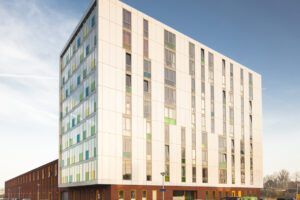

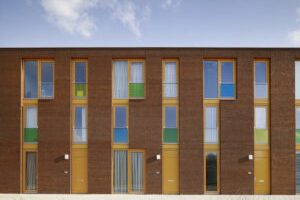
The 'Super-Shell' housing system offers maximum freedom for personalization. The houses are sold empty, providing only the structure and facades, allowing users to choose the position of installations within the house. This strategy empowers users to become the architects of their own homes, increasing personalization possibilities. The system offers seven different layouts printed on transparent paper, allowing users to combine and choose the most suitable configuration for their lifestyle. A catalog of facade types is also provided to enhance personalization based on light, views, and open-air spaces. The exterior personalization reflects the contrast between individual and collective identity, while avoiding the uniformity of the first modernity housing system. Additionally, a nine-story tower with flexible housing typology, including apartments for people with disabilities, was added to the project, along with new public spaces.
The ‘Super-Shell’ houses system provides the user maximum level of freedom to personalize his house. The house is sold completely empty, offering only the structure and the facades, without any installations or rooms inside. Three strategically holes located in the floors allow the user to choose the position of the installations within the house after bying it. In this project several strategies have been applied to allow the personalization of the houses:
By choosing this strategy, the house is thought and designed by the user under certain frame conditions. The user becomes the architect of his house in the same way he is becoming nowadays the architect of his own life.
The possibility of placing kitchen, toilets and bathrooms in very different positions, combined with the flexibility of choosing the position for the rest of the rooms, increases enormously the number of possible layouts of the house and its level of personalization.
Another strategy tested in this project to offer a wide range of possibilities to personalize the houses, has been to provide seven different layouts of ground floors, first floors and second ones printed on transparent paper. The user has been able to combine the transparent papers to decide which layout suits better his way of living.
In total 343 layouts are possible with this system.
A catalogue of different façade types has also been provided to personalize further the house in order to satisfy the interior necessities of light, views and possible open air spaces.
On the one hand the personalization of the exterior of the house reinforces the contrast between individual and collective identity and reflects the social conflict between individualization and society. On the other hand the personalization of the house avoids the typical result of the housing system of the first modernity according to which every family had the same identical dwelling with the same appearance.
The nine-storey tower added during the development process, contains 16 apartments for people with disabilities +25 apartments, with a super-flexible housing typology and with some new public spaces.
Toa Architects, victorious in the Europan 3 competition, secured a contract to design a youth hostel funded by Mulhouse Habitat and the PUCA. The "experimental project" prioritized architectural flexibility, creating a transformative space that seamlessly transitions from private to communal areas, promoting resident autonomy and social interaction.
After the Europan 3 competition, the winning team Toa architects get a contract for a young workers hostel, financed by Mulhouse Habitat and the PUCA (Urban Planning, Architecture and Construction) with 82 bedrooms, common areas and public facilities.
The “experimental project” label and the great involvement of the client allowed architectural dispensations and the possible interpretation by the team of the rules in order to create a mixed space where uses would have the ability to modify relationships between people.
The architecture operates like a filter, expressing the gradual movement from privacy to sociability, at both individual and group scale. Two buildings are positioned parallel to the street: the first, lower building, accommodates the communal spaces that are open to the districts, together with the spaces representing the institution; the second, three-storey building, is set back, and contains the living areas and communal spaces associated with the residential function. A basement level garden organises the relation between the two buildings and offers an intimacy space, protector, more private.
The centre is designed to give the resident’s choice, the meeting or avoidance, balance between independence and communal living: choice in the residential access routes to the living spaces, choice to live at home or to enjoy sociability spaces, choice in the housing interior of several configurations through the interplay of dual-position swing doors.
The housing units also reflect the variety of demand, ranging in type from maximum autonomy to maximum communality. All aimed at favouring random meetings, internal evolution, the passage from solitude, to life as two, as, couple, a family with children: “maisonnette”, single rooms, paired rooms, adaptable rooms for couples or single-parent families, shared apartments for four residents.

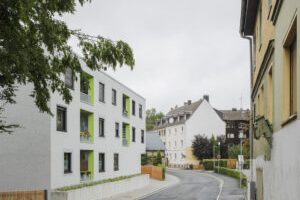

1st Prize Implementation: IQ Experimental Subsidized Housing in Selb (IQ innerstädtische Wohnquartiere) is a state-subsidized program included in an experimental regional initiative from the Bavarian Ministry of Construction to revitalize the central areas of a group of selected cities in Bavaria, Germany. The construction of the IQ Housing Project is the result of the 1st Prize won in the Invited International Competition «IQ Innerstädtische Wohnquartiere».
Urban regeneration: this new input from the regional government of Bavaria fits perfectly and is smoothly integrated in the Europan 9 open-process of urban regeneration for the iiner city of Selb. The IQ Project followa the main principles of the Preventive Urban Acupuncture Therapy started in 2008: it´s focused in the revitalization of the inner city, is an architecture intervention with a strong urban impact (connecting two different levels of the city), and is oriented to young families, completing the Europan 9 demographic-oriented projects for babies, children, teenagers and young people.
Revisiting the everyday life: the residential program is composed of 26 apartments for young families, with parking lots, cellars, and a district heating biomass power plant. The urban layout is an answer to the local climate in order to establish democratic sunlight conditions, giving also, the same cross-ventilation features to all. The sun is the dominant vector in the project. The blocks are artitulated with a type of half-open hallways, with permeable facades, working as thermal regulators and providing the first shared space for the community. The apartments are designed around an outdoor and covered loggia, a green-room which is always oriented to the sun. The housing units are organized with a strip of services and installations, which frees the rest of areas making possible many settings throughout the time.